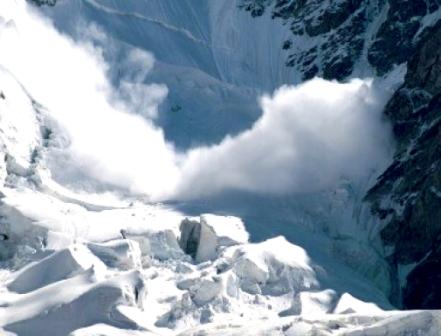What is an Avalanche? |
|
Snow is deposited in successive layers as the winter progresses.
|
|
These layers may have dissimilar physical properties and an avalanche occurs when one layer slides on another (Surface Avalanche), or the whole snow cover slides on the ground (Full-Depth).
|
Why do Avalanches happen? |
|
Avalanches can happen wherever there is snow lying on ground of sufficient angle.
|
|
Accidents in recent years in most mountain areas, demonstrate the truth of this statement.
|
|
The vastly increased popularity of winter climbing and hill walking, along with the growth of interest in ski touring means that greater numbers are at hazard.
|
|
Sadly, each year adds to the list of injuries or fatalities.
|
|
Even the snow packed down on the surface cannot support itself with all the weight.
|
 |
|
When another factor is introduced, such as a person’s step, this helps to loosen the snow and an avalanche occurs.
|
|
Major temperature changes, rapid wind speed and man-made influences are the main causes of why avalanches occur.
|
|
Most avalanches begin within weak layers of snow, which evolve within the snowpack or form on top of the snow and become buried.
|
|
Eventually these weak layers can no longer hold up the weight on the overlying snow, and will give way causing the snow above them to break free and slide downhill.
|
 |
Where and when Avalanches can happen? |
|
Avalanches happen on mountains with extreme amounts of slow fall and build-up.
|
 |
|
Wherever snow is lying on ground on an extreme and sufficient angle there is potential for a sleeping avalanche.
|
|
The steadily increasing numbers in popularity of winter activities along with the growth of interest in skiing has resulted in a much greater hazard.
|
|
There are many sites around the world that are potential or have already experienced avalanches.
|
|
Europe, France, Swiss mountains, Western Canada, Utah, Alaska, and Colorado are just a few places that have high probability of avalanches.
|
Watch this video !
|
Kinds of Avalanches |
|
Slab avalanches:
|
|
Most people that die in avalanches, die in slab avalanches. Slab avalanches occur when a more cohesive or harder layer of snow sets on top of a less cohesive or softer and weaker layer of snow. Sometimes the weak layer can barely support the layers above it and when additional weight like a skier or boarder is added to the upper layers, the weak layer collapses and the snowpack fractures and a slab avalanche occurs.
|
|
|
|
Sluffs or loose snow avalanches:
|
|
Sluffs are cold snow powdery surface slides that typically are the least dangerous type of slide; however, sluffs can and often do injure skiers and boarders by pushing them over cliffs and rock bands in steep terrain.
|
|
|
|
Wet avalanches:
|
|
Wet slides occur when warm temperatures melt the surface snow layers and saturate them with water. The water weakens the bonds between layers and avalanches often occur. Wet avalanches move more slowly than dry avalanches but they can still be very dangerous.
|

A glimpse of a slab avalanche
|